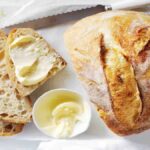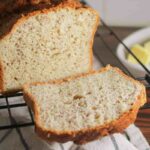Unlock the secrets to effortlessly baking delicious, no-yeast gluten-free bread! This comprehensive guide dives into the art of crafting light and airy loaves using diverse gluten-free flour blends, from the nutty richness of almond flour to the subtle sweetness of coconut flour. We’ll explore various recipes, offering step-by-step instructions, ingredient substitution options, and troubleshooting tips to ensure your baking journey is a resounding success. Prepare to tantalize your taste buds and impress your friends and family with homemade gluten-free bread that’s both healthy and incredibly flavorful.
Imagine the warm, inviting aroma filling your kitchen as golden-brown loaves emerge from the oven, their crust boasting a delightful crispness, yielding to a soft, airy interior. We’ll guide you through the nuances of each flour blend, revealing how subtle adjustments in baking time and temperature can transform the texture and taste of your creation. Discover the joy of experimenting with different sweeteners and milk alternatives, tailoring the recipe to your preferences and dietary needs. Through detailed explanations and helpful visuals, you’ll gain the confidence to master the art of gluten-free baking, producing bread that rivals—and perhaps even surpasses—traditional recipes.
Ingredient Substitutions and Adaptations

This section explores the versatility of gluten-free, no-yeast bread baking by showcasing three variations of a single base recipe. We’ll examine how swapping specific ingredients affects the final product’s texture, taste, and nutritional profile, empowering you to tailor your bread to your preferences and dietary needs. Understanding these substitutions allows for greater creativity and flexibility in the kitchen.
Basic Gluten-Free No-Yeast Bread Recipe and Variations
The following recipe serves as our foundation: 1 cup gluten-free all-purpose flour blend, ½ cup almond flour, ¼ cup tapioca starch, 1 teaspoon baking powder, ½ teaspoon xanthan gum, 1 teaspoon salt, 1 tablespoon olive oil, 1 cup milk (dairy or non-dairy), and ½ cup honey or maple syrup. Mix dry ingredients, then wet, combining until just moistened. Bake in a greased loaf pan at 350°F (175°C) for 45-50 minutes, or until a toothpick inserted into the center comes out clean.
- Variation 1: Using Coconut Milk and Coconut Sugar: Substituting coconut milk for the standard milk and coconut sugar for honey creates a subtly sweet, tropical-flavored bread. The coconut milk adds a rich, creamy texture, while the coconut sugar imparts a unique caramel-like sweetness. The baking time might need a slight increase, perhaps by 5-10 minutes, to account for the higher moisture content of coconut milk. This variation offers a boost in healthy fats from the coconut milk and a slightly lower glycemic index due to the coconut sugar. Imagine the warm, golden-brown loaf, its crumb studded with tiny pockets of air, exuding a gentle aroma of toasted coconut.
- Variation 2: Incorporating Rice Milk and Agave Nectar: Replacing the milk with rice milk and honey with agave nectar results in a lighter, slightly less sweet bread. Rice milk contributes a mild flavor, allowing other ingredients to shine. Agave nectar provides a gentler sweetness than honey. This version might need a few minutes less baking time due to the lower viscosity of rice milk. The nutritional profile shifts slightly, offering a different balance of carbohydrates and a lower fat content compared to the original recipe. The finished bread will have a delicate, airy texture, a soft, almost fluffy crumb, and a subtly sweet taste.
- Variation 3: Utilizing Oat Milk and Brown Rice Syrup: Substituting oat milk for the original milk and brown rice syrup for honey produces a bread with a slightly nutty flavor and a chewier texture. Oat milk adds a subtle creaminess and a hint of oat flavor. Brown rice syrup lends a deeper, more complex sweetness compared to honey. No significant adjustments to baking time are typically needed. This variation provides a richer source of fiber and slightly different carbohydrate profile than the original. The final product will boast a warm, golden-brown crust, and a dense, moist crumb with a pleasant nutty aroma.
Baking no-yeast gluten-free bread doesn’t have to be daunting. With the right techniques and a little practice, anyone can achieve perfectly textured, flavorful loaves. This guide empowers you to explore the world of gluten-free baking, offering a range of recipes and tips to ensure success. From the satisfying crunch of the crust to the tender crumb within, each bite will be a testament to your baking prowess. So, gather your ingredients, preheat your oven, and embark on this rewarding culinary adventure. The delicious results will speak for themselves, leaving you with the pride of crafting truly exceptional gluten-free bread.
Frequently Asked Questions
Can I use a different type of sweetener?
Yes, many sweeteners can be substituted, but the results may vary in taste and texture. Experiment cautiously, adjusting other ingredients as needed.
How long can I store the bread?
Store leftover bread in an airtight container at room temperature for up to 3 days or freeze for longer storage.
What if my bread is too dense?
This could be due to overmixing or insufficient leavening. Ensure you’re using the correct amount of ingredients and avoid overmixing the batter.
Can I make this bread in a bread machine?
While not explicitly designed for bread machines, you can adapt some recipes by adjusting the liquid content and baking time. Consult your machine’s manual for guidance.
Are there any nut-free alternatives?
Yes, you can substitute certain nut flours with other gluten-free options like tapioca flour or potato starch, but the texture and taste will differ.


